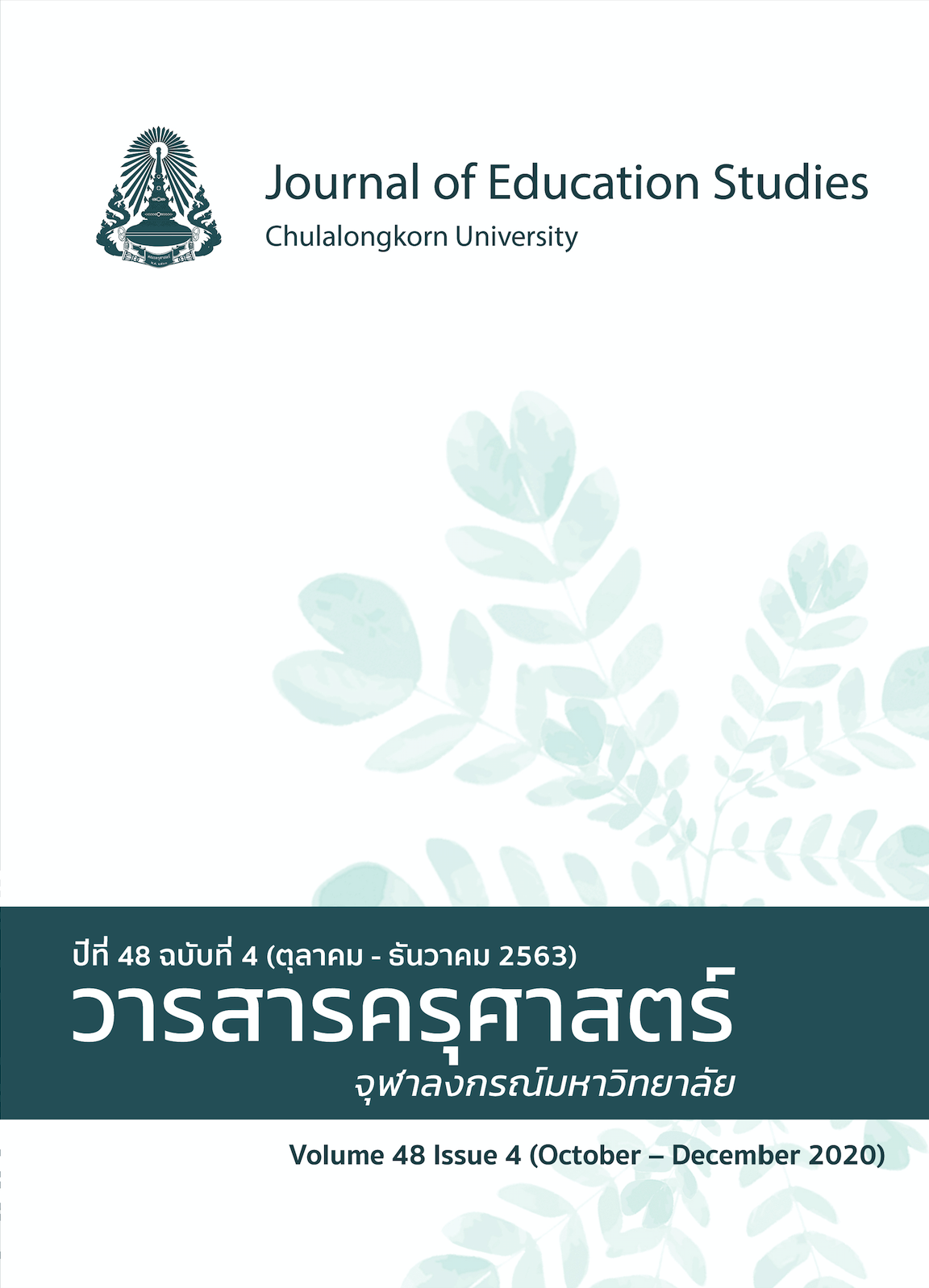A Needs Assessment of Active Learning of Faculty of Education Lecturers
Keywords:
needs assessment, active learning, faculty of educationAbstract
The purpose of this research was 1) to analyze the active learning states of lecturers in the Faculty of Education, and 2) to identify their active learning needs. A sample of 301 lecturers from the Faculty of Education responded to an active learning questionnaire with a dual-response format and a five-level rating scale. The data were analyzed using descriptive statistics, using the percentage, mean, standard deviation, and a Modified Priority Needs Index (PNI modified). The results showed the following: 1) the teachers, students, teaching activities, and learning, measurement and evaluation materials were all found to be of a high level, with the lowest score reported for the student component (M = 3.67, SD = 0.80), and 2) the active learning needs of the lecturers calculated using the PNI modified were related to the needs of the students (0.22), teaching activities (0.16), and measurement and evaluation (0.16), respectively.
References
ขวัญชัย ขัวนา, ธารทิพย์ ขัวนา, และ เลเกีย เขียวดี. (2561). การพัฒนารูปแบบการเรียนการสอนเพื่อส่งเสริมทักษะการเรียนรู้ในศตวรรษที่ 21. วารสารมนุษยศาสตร์และสังคมศาสตร์ มหาวิทยาลัยมหาสารคาม, 37(2), 77-96. http://www.journal.msu.ac.th/upload/articles/article2126_41794.pdf
ดวงใจ งามศิริ, นิภาพร บุญยศ, และ นิพล พินิจวัจนะวงศ์. (2562). การจัดการเรียนการสอนแบบ Active learning โดยใช้รูปแบบ MACRO model ในรายวิชาการประมวลผลแบบกลุ่มเมฆ. วารสาร มจร นครน่านปริทรรศน์, 3(2), 69-80. http://www.ojs.mcu.ac.th/index.php/mcu-nan/article/view/
4388/3279
บุญชม ศรีสะอาด. (2553). การวิจัยเบื้องต้น (พิมพ์ครั้งที่ 8). สุรีวิริยาสาส์น.
ปิยพงษ์ คล้ายคลึง. (2551). แนวทางการพัฒนาระบบและกระบวนการประกันคุณภาพการศึกษา : กรณีศึกษามหาวิทยาลัยเน้นการผลิตบัณฑิตและวิจัยของรัฐแห่งหนึ่งในเขตกรุงเทพมหานคร [วิทยานิพนธ์ดุษฎีบัณฑิต]. Chulalongkorn University Intellectual Repository (CUIR). http://cuir.car.chula.ac.th/handle/123456789/62094
พวงพยอม ชิดทอง และ ปวีณา โฆสิโต. (2560). บทบาทของอาจารย์ในการส่งเสริมทักษะการเรียนรู้ในศตวรรษที่ 21 สำหรับบัณฑิตไทย. พิฆเนศวร์สาร, 13(1), 1-11. https://so01.tci-thaijo.org/index.php/
pikanasan/article/view/97882/76262
วัฒนา หงสกุล. (2561). การจัดการเรียนรู้เชิงรุกในยุคไทยแลนด์ 4.0. รายงานการประชุมวิชาการเสนอผลงานวิจัยระดับชาติ “Graduate school conference 2018”, 1(2), 479-486. http://journalgrad.ssru.ac.th/index.php/miniconference/article/view/1642
สิทธิพงษ์ สุพรม. (2561). การพัฒนาความสามารถในการเรียนรู้เชิงรุกในศตวรรษที่ 21 สำหรับนักเรียนชั้นมัธยมศึกษาตอนต้น. วารสารวิจัยและประเมินผลอุบลราชธานี, 7(2), 49-58. https://so06.tci-thaijo.org/index.php/ubonreseva/article/view/149198/119040
สุชาดา แก้วพิกุล. (2555). การพัฒนากิจกรรมคณิตศาสตร์ที่ใช้การจัดการเรียนการสอนอย่างกระตือรือร้นโดยเน้นการเรียนเป็นคู่ร่วมกับการบริหารสมองเพื่อส่งเสริมผลสัมฤทธิ์ทางการเรียนและความสุขในการเรียนของนักเรียนชั้นมัธยมศึกษาปีที่ 2 ที่มีผลสัมฤทธิ์ทางการเรียนต่ำ [วิทยานิพนธ์ปริญญามหาบัณฑิต]. Srinakharinwirot University Institutional Repository. http://ir.swu.ac.th/jspui/handle/123456789/3753
สุภัทรา ภูษิตรัตนาวลี. (2560). การพัฒนารูปแบบการจัดการเรียนรู้เชิงรุกสำหรับคณาจารย์วิทยาลัยเทคโนโลยีภาคใต้ [วิทยานิพนธ์ปริญญาดุษฎีบัณฑิต]. Behavioral Science Research Institute Search (BSRIS). http://bsris.swu.ac.th/thesis/55199120027RB8992555f.pdf
สุวิมล ว่องวาณิช. (2558). การวิจัยประเมินความต้องการจำเป็น (พิมพ์ครั้งที่ 3). สํานักพิมพ์แห่งจุฬาลงกรณ์มหาวิทยาลัย.
แสงสุรีย์ ดวงคำน้อย. (2561). การเรียนรู้เชิงรุก : กิจกรรมท้าทายสำหรับผู้เรียนในยุคการศึกษา 4.0. วารสารวิชาการและวิจัย มหาวิทยาลัยภาคตะวันออกเฉียงเหนือ, 8(3), 61-71. https://so04.tci-thaijo.org/index.php/neuarj/article/view/196788/136790
ภาษาอังกฤษ
Coorey, J. (2016). Active learning methods and technology: Strategies for design education. The International Art & Design Education, 35(3). 337-347. https://doi.org/10.1111/jade.12112
McKinney, K., & Heyl, B., (Eds.). (2008). Sociology through active learning (2nd ed.). SAGE/Pine Forge.
Michel, N., Cater, J., & Varela, O. (2009). Active versus passive teaching styles: An empirical study of student learning outcomes. Human resource development quarterly, 20(4), 397-418. https://doi.org/10.1002/hrdq.20025
Naithani, P. (2008). Reference framework for active learning in higher education. Higher Education in the Twenty-First Century: Issues and Challenges, 113-120. https://www.researchgate.net/publication/282124753_Reference_framework_for_active_learning_in_higher_education




